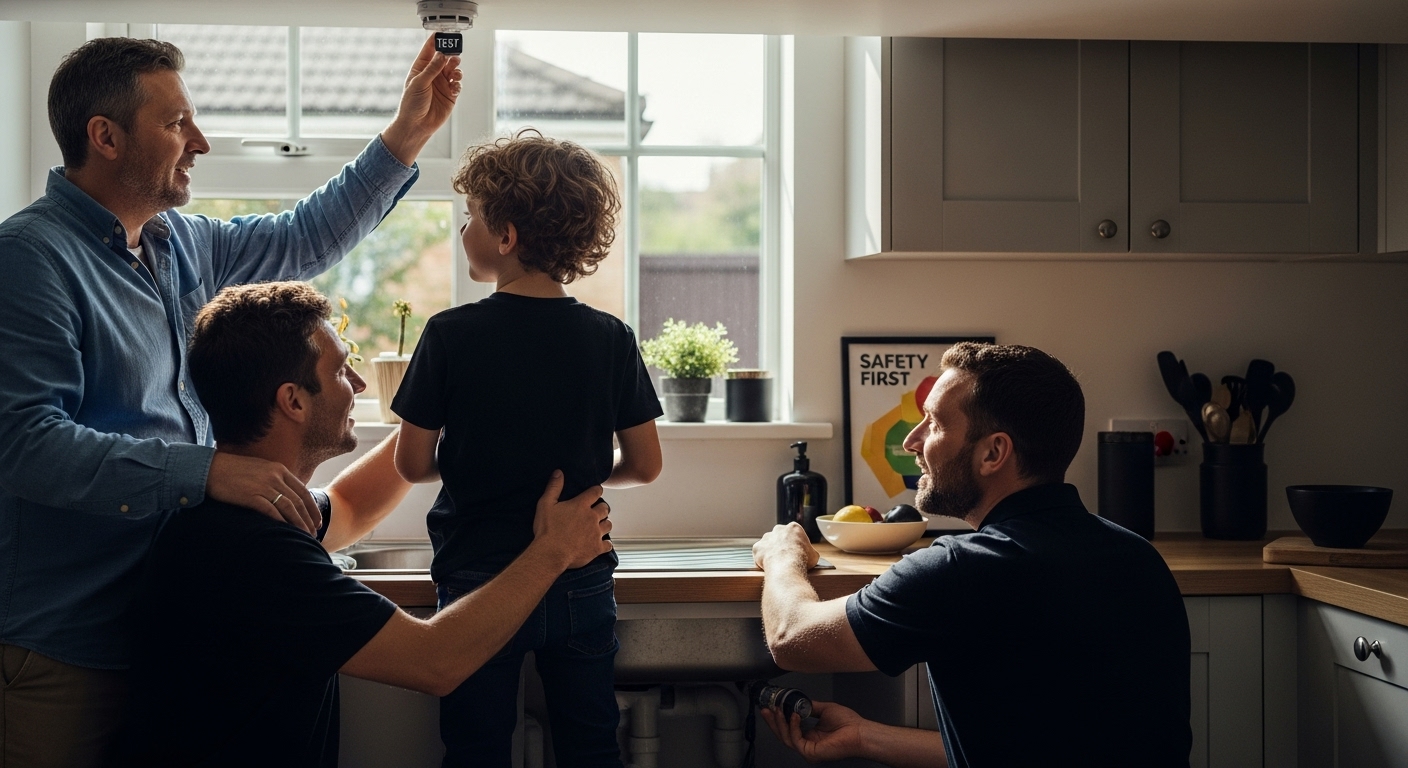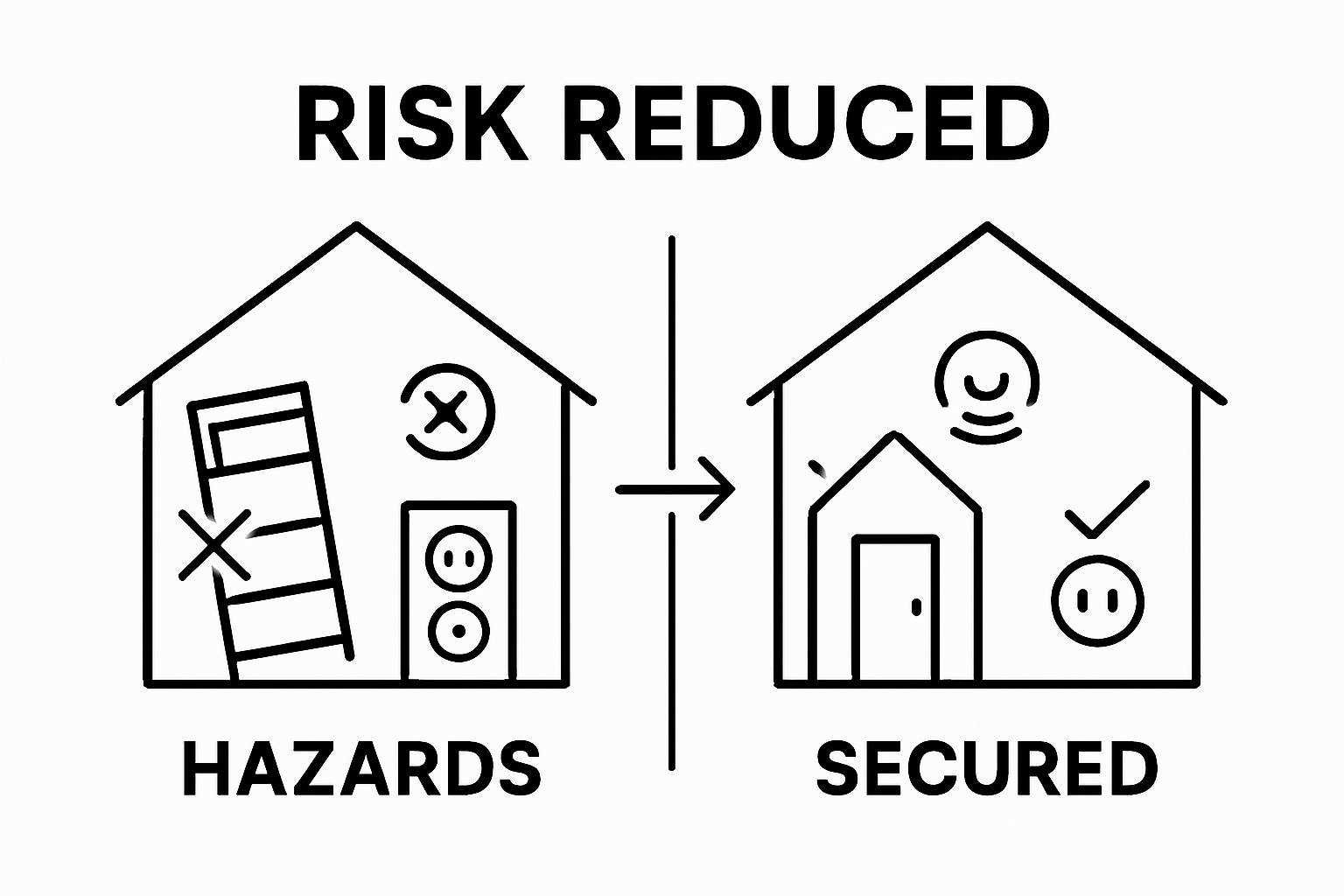
A home might look safe on the surface, but everyday spaces can hide dangers most families never notice. Shockingly, thousands of preventable accidents happen in homes each year, many from risks that stay invisible until it is too late. The real surprise is that you do not need expensive gadgets or complicated solutions to protect your family. A simple home safety checklist gives you complete control over the hidden risks in your own space.
Table of Contents
- What Is A Home Safety Checklist And Its Purpose?
- Why A Home Safety Checklist Matters For Every Family
- How A Home Safety Checklist Protects Your Home And Loved Ones
- Key Elements Of An Effective Home Safety Checklist
- Real-World Impact Of Implementing A Home Safety Checklist
Quick Summary
| Takeaway | Explanation |
|---|---|
| Regularly inspect for hazards | Conduct frequent assessments to identify potential risks in your home. |
| Focus on child safety features | Ensure outlets and furniture are secure to prevent accidents in homes with kids. |
| Maintain fire and safety equipment | Regularly check smoke detectors and fire extinguishers to ensure they function properly. |
| Document and track safety issues | Keep records of identified hazards and maintenance actions for ongoing safety improvement. |
| Adopt a culture of safety | Promote awareness within the household to foster proactive safety behaviors among all family members. |
What is a Home Safety Checklist and Its Purpose?
A home safety checklist is a systematic approach to identifying and mitigating potential risks within a residential environment. More than just a simple document, it serves as a comprehensive tool that helps homeowners proactively protect themselves, their families, and their property from potential hazards and accidents.
Understanding the Core Purpose
The primary objective of a home safety checklist is prevention. By methodically examining different areas of your living space, you can detect potential dangers before they become serious problems. According to Johns Hopkins Medicine, these checklists are crucial in reducing unintentional injuries and creating a secure living environment.
Key purposes of a home safety checklist include:
- Identifying potential safety risks in different home areas
- Creating a structured approach to home maintenance
- Developing a proactive mindset toward household safety
- Establishing a regular inspection routine
Components of an Effective Safety Checklist
An effective home safety checklist typically covers multiple aspects of residential safety. These comprehensive evaluations go beyond simple visual inspections and require a detailed, room-by-room examination of potential hazards.
The checklist usually encompasses critical areas such as:
- Electrical system integrity
- Fire prevention and detection equipment
- Structural vulnerabilities
- Potential environmental risks
- Emergency preparedness mechanisms
By systematically addressing these components, homeowners can significantly reduce the likelihood of accidents, injuries, and property damage.
Below is a table summarizing the core components commonly found in an effective home safety checklist, providing a clear at-a-glance understanding of each assessment area and its focus.
| Component | Purpose/Focus |
|---|---|
| Electrical System Integrity | Ensure safe wiring, outlets, and prevent shocks |
| Fire Prevention & Detection | Install and maintain alarms, extinguishers, exits |
| Structural Vulnerabilities | Identify weak flooring, stairs, or supports |
| Environmental Risks | Check for mold, water leaks, or air quality issues |
| Emergency Preparedness Mechanisms | Stock emergency kits, plan escape routes |
| Personal Safety Equipment | Inspect and test safety gear (helmets, detectors) |
The goal is not to create anxiety but to empower individuals with knowledge and practical strategies for maintaining a safe living environment.
Implementing a regular home safety checklist transforms passive living into an active, preventative approach to household management. It represents a commitment to protecting what matters most your family, your health, and your home.
Why a Home Safety Checklist Matters for Every Family
Home safety is not a luxury but a fundamental necessity for protecting your family and preserving your living environment. A comprehensive home safety checklist transcends mere precaution, serving as a critical strategy for preventing potential risks and ensuring a secure household.
The Hidden Risks in Your Living Space
Many families underestimate the potential dangers lurking within their homes. Everyday environments can harbor unexpected hazards that might seem innocuous but can lead to serious injuries or property damage. According to Nationwide Children’s Hospital, numerous household accidents occur annually, many of which could be prevented through proactive safety measures.
Potential hidden risks include:
- Unsecured furniture that could tip over
- Electrical outlets without proper child safety covers
- Unnoticed structural weaknesses
- Inadequate fire and carbon monoxide detection systems
- Poorly maintained appliances and equipment
Financial and Emotional Protection
Beyond physical safety, a home safety checklist provides significant financial and emotional protection. Preventing accidents can save families from potentially devastating medical expenses and emotional trauma associated with preventable injuries.
This table compares the key protective benefits of implementing a home safety checklist, making it easier to see the financial and emotional impacts alongside the safety benefits.
| Protective Benefit | Description |
|---|---|
| Reduced Medical Costs | Prevents injuries, lowering expenses for treatment |
| Minimized Insurance Claims | Decreases risk of claims and premium increases |
| Avoidance of Rehabilitation Expenses | Reduces potential for long-term rehab needs |
| Emotional Peace of Mind | Less stress and worry from preventable accidents |
| Protection from Life-Altering Accidents | Prevents major incidents that can drastically affect families |
Key protective benefits include:
- Reducing potential medical treatment costs
- Minimizing insurance claims and premium increases
- Preventing long-term rehabilitation expenses
- Protecting family members from potential life-altering accidents
By implementing a systematic approach to home safety, families transform their living spaces from potential danger zones into secure, nurturing environments. This proactive strategy demonstrates a profound commitment to family well-being, ensuring that your home remains a sanctuary of comfort and protection.
How a Home Safety Checklist Protects Your Home and Loved Ones
A home safety checklist serves as a comprehensive shield, strategically defending your most valuable assets your family and your property. By systematically addressing potential vulnerabilities, this tool transforms passive living spaces into proactively protected environments.
Comprehensive Risk Mitigation
Protecting your home requires more than simple intuition. According to the U.S. Consumer Product Safety Commission, strategic safety assessments can dramatically reduce the likelihood of accidents and structural failures. The checklist acts as a diagnostic tool, revealing hidden risks that might otherwise go unnoticed.
Key protection mechanisms include:
- Identifying structural vulnerabilities before they escalate
- Detecting potential electrical and fire hazards
- Assessing environmental risks like mold or water damage
- Evaluating emergency preparedness systems
- Reviewing personal safety equipment functionality
Layered Defense Strategy
A home safety checklist operates through a multilayered defense strategy. It does not merely react to problems but anticipates and neutralizes potential threats before they materialize. This proactive approach involves continuous monitoring and systematic evaluation of different home environments.
Critical protection layers encompass:
- Physical infrastructure assessment
- Technological safety systems evaluation
- Personal behavior and preparedness monitoring
- Regular maintenance and upgrade recommendations
- Age and lifestyle specific risk assessments
By implementing a comprehensive home safety checklist, families create a dynamic protective framework. This approach goes beyond traditional safety measures, offering a holistic strategy that adapts to changing household dynamics and emerging potential risks. The ultimate goal is not just prevention but creating a resilient, secure living environment where family members can thrive with confidence and peace of mind.
Key Elements of an Effective Home Safety Checklist
Creating a comprehensive home safety checklist requires strategic planning and meticulous attention to detail. The most effective checklists transform complex safety considerations into actionable, systematic evaluations. Homeowners can develop robust protection strategies by understanding and implementing critical elements that address various potential risks.
Foundational Safety Assessment Components
According to the San Francisco Department of Building Inspection, a thorough home safety checklist must encompass multiple critical domains. These foundational components serve as a comprehensive framework for identifying and mitigating potential household hazards.
Key assessment areas include:
- Structural integrity evaluation
- Electrical system inspection
- Fire prevention and emergency preparedness
- Environmental risk assessment
- Personal safety equipment verification
To support your organizational efforts, you might find our 10 Home Organization Tips for a More Tidy and Efficient Living Space guide helpful in creating a more systematic approach to home management.
Comprehensive Risk Management Strategy
An effective home safety checklist goes beyond simple inspection. It represents a dynamic, adaptive approach to household protection that evolves with changing living conditions and emerging potential risks.
Critical strategic elements encompass:
- Regular scheduled assessments
- Age and lifestyle specific risk considerations
- Documentation and tracking of identified issues
- Continuous learning and adaptation
- Professional consultation and expert guidance
By implementing a holistic approach, families can transform their home safety checklist from a static document into a living, breathing protection strategy. This proactive methodology ensures that potential vulnerabilities are not just identified but systematically addressed, creating a secure and resilient living environment.

Real-World Impact of Implementing a Home Safety Checklist
Home safety checklists transform theoretical protection strategies into tangible, life-saving interventions. By bridging the gap between awareness and action, these systematic approaches provide families with a powerful tool for preventing potential accidents and mitigating risks in their living environments.
Quantifiable Safety Improvements
According to research published in PubMed, implementing comprehensive home safety checklists can significantly reduce household hazards. Professional home healthcare paraprofessionals trained in using detailed safety assessment tools identified critical risks that might otherwise remain unnoticed.
Key measurable improvements include:

- Reduction in potential accident rates
- Enhanced early detection of safety vulnerabilities
- Systematic documentation of household risks
- Increased awareness of potential environmental hazards
- Proactive risk management strategies
To complement your safety efforts, you might find our Having Fun While Staying Tidy guide helpful in maintaining an organized and secure living space.
Long-Term Prevention and Protection
Implementing a home safety checklist goes beyond immediate risk mitigation. It represents a comprehensive approach to creating a resilient, protected living environment that adapts to changing household dynamics and individual needs.
Long-term protective benefits encompass:
- Developing a safety-conscious household culture
- Reducing potential medical and property damage expenses
- Creating generational safety awareness
- Establishing consistent maintenance and inspection routines
- Building confidence in personal and family protection strategies
By adopting a proactive approach to home safety, families can transform their living spaces from potential risk zones into secure, nurturing environments. This methodical strategy not only prevents accidents but also cultivates a deeper understanding of personal safety and environmental awareness.
Turn Your Home Safety Checklist Into Real Peace of Mind
Every family wants a safe home, but it is often daily clutter, overflowing closets, and crowded cabinets that keep you from truly achieving the peace of mind described in your home safety checklist. The article highlights how hidden risks—like blocked exits or items stacked too high—can turn into hazards. Tackling these problems starts with a tidy, well-organized living space built on simple, sustainable routines.

Ready to make every checklist step easier and more effective? Visit Blush Bees for trusted home organization solutions. Our durable storage boxes, baskets, and containers help you eliminate chaos and reduce risks, so every area is both stylish and safe. Give yourself and your loved ones the gift of a truly protected home—explore our expert storage products and specials now. Start your journey toward a tidier, safer space today.
Frequently Asked Questions
What is the purpose of a home safety checklist?
A home safety checklist is designed to identify and mitigate potential risks within a residential environment, helping homeowners prevent accidents and create a secure living space.
How often should I check my home safety checklist?
It is recommended to conduct a home safety checklist regularly, ideally every six months, or whenever significant changes occur in your household or living conditions.
What key areas should be included in a home safety checklist?
A comprehensive home safety checklist should include assessments of the electrical system, fire prevention and detection equipment, structural integrity, environmental risks, and emergency preparedness mechanisms.
How can implementing a home safety checklist benefit my family?
Implementing a home safety checklist helps prevent accidents, reduces potential medical costs, minimizes property damage, and fosters a culture of safety awareness within the household.
Recommended
- Having Fun While Staying Tidy. Is It Possible? – BLUSHBEES USA
- Where to Start When Your Whole House is a Mess: Expert Tips – BLUSHBEES USA
- A tidy home can reduce stress and anxiety. It also enhances focus and clarity, promoting mental wellness. – BLUSHBEES USA
- A tidy home can reduce stress and anxiety. It also enhances focus and clarity, promoting mental wellness. – BLUSHBEES USA



